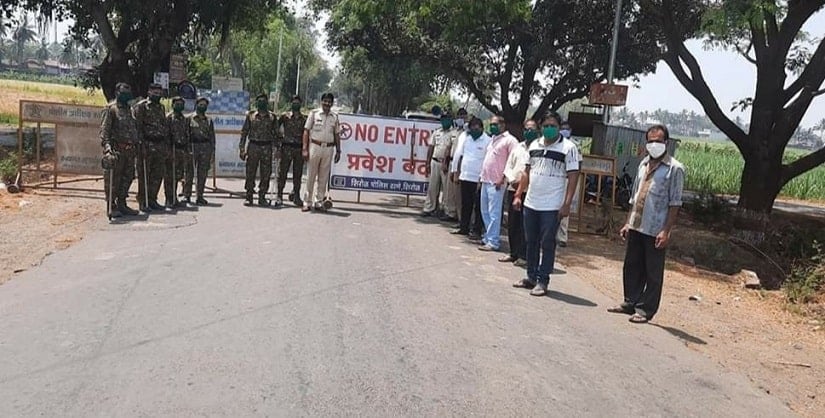In the August 2019 floods, Arjunwad (population: 5,641) was among the villages in Maharashtra that was completely submerged. A mere seven months later, before they could recover from the devastation of the deluge, Arjunwad’s residents are grappling with the consequences of the coronavirus outbreak.
In the August 2019 floods, Arjunwad (population: 5,641) was among the villages in Maharashtra that was completely submerged. A mere seven months later, before they could recover from the devastation of the deluge, Arjunwad’s residents are grappling with the consequences of the coronavirus outbreak. Sixty five-year-old Chhaya Kamble is among those residents. On 25 March, at about 4.30 pm, Chhaya, a tenant farmer, was hurrying through the lanes of Arjunwad, a mask covering the lower half of her face, a 5 kg basket of green chillies held atop her head. She had an hour-and-a-half to sell the entire lot. In the usual course, Chhaya sells her produce in the markets of Shirol and Miraj, four times a week. However, after the state government sealed district borders to contain the spread of the coronavirus, the authorities at Arjunwad too blocked the village’s entry and exit points, thereby curtailing the movements of farmers like Chhaya. That late afternoon, as she sold her chillies, she was apprehensive about being exposed to the coronavirus, but noted that she couldn’t just stay home. “People need vegetables. How will they survive?” she asked. After the statewide curfew imposed by the Maharashtra government, Arjunwad’s residents were asked to adhere to specific timings for venturing outside their homes. Chhaya’s son Chaitanya Kamble, a journalist, told me the timings were 7 am to 9 am, and then from 4.30 pm to 6 pm. “This is the time farmers go to the fields to bring in fodder and sell milk at the dairies. You can go outside your house only if there’s some urgent, unavoidable work,” he said. [caption id=“attachment_8220301” align=“alignnone” width=“825”]
 Local police and village authorities enforce the curfew in Maharashtra’s Arjunwad village[/caption]
![5-min]()
The August 2019 floods had ravaged the Kambles’ one acre plot, on which they cultivated a few vegetables and groundnuts. “We incurred a loss of about 12 sacks (roughly 500 kg),” Chhaya said. When the family could farm the land again, in October, they planted sugarcane on 37 gunta (0.925 acres) and green chillies in the remaining three guntas. “First, there was the fear of flood, now this virus and what’s next?” she wondered. “Is there another flood waiting for us?” Click
here to follow LIVE updates on the coronavirus outbreak. Announcing the curfew, Maharashtra chief minister Uddhav Thackeray had
reassured farmers and agricultural labourers that they wouldn’t be prevented from going to their fields. With time restrictions set by local authorities, however, some Arjunwad residents are apprehensive. “Earlier, there was no work in the fields because of the floods. Now when there is work in the fields, we can’t go out because of the virus, and by the time we will go out, there will be another flood,” said Sarika Koli, who lives in a 12-member joint family that collectively owns 12 heads of cattle. “How will we find fodder for the animals if we can’t go out?” she asked. For Sarika, milking the cattle remains an important source of livelihood, and this too is under threat due to lack of access to fodder. Arjunwad’s authorities are right to be cautious of course, especially in view of the poor condition of rural healthcare. (Rural Maharashtra has a total of 12,398 beds in government hospitals
as per the National Health profile, 2019.) But for agricultural labourers, limiting their time in the fields translates into an impending crisis: fodder for their cattle comes from the fields they work in; if they can’t work and collect the fodder, the cattle will suffer; in turn, impacting the dairy industry, which was helping flood-affected villagers survive. [caption id=“attachment_8220371” align=“alignnone” width=“825”]
 Scenes of devastation from the August 2019 floods in Arjunwad. Photos by Sanket Jain[/caption]
![3-min]()
![4-min]()
Sarika, like others in the village, lost two months of work (August-September 2019) due to the floods. “For a month, we had to stay outside the village, on the roads,” she said. Now, when they attempt to leave their homes, the villagers fear being beaten by the police, or fined. “How can we pay any fine?” asked Sarika, who earns Rs 200 for eight hours of work daily. As per a Maharashtra Times
report, 41,034 homes were destroyed (partially or fully) by the August floods in the Kolhapur district. With 11,275 homes destroyed (partially or fully), Shirol taluka remained the worst affected in Kolhapur. The houses are yet to be rebuilt and the flood-affected — still awaiting promised compensation — had no option but to stay in rented homes. Maharashtra has reported over 300 Covid-19 cases till date, even as the national count has reached 1,965. As an Indian Express
report recently noted, “There is one isolation bed per 84,000 Indians, and one quarantine bed per 36,000.” Families are struggling with their new reality amid the lockdown. Sadashiv Kanal, 27, worries about his father, Mahadev, 50, who cuts sugarcane with a few other labourers from 7 am to 6 pm daily. “What can we do? It’s the crushing season and the cane has to be cut. What will we eat?” Sadashiv fretted. Sadashiv is employed by a contractor in Sangli, but for over 10 days, there has been no work. The Kanals owns four goats and two buffaloes, and worry about running out of fodder for the cattle. Sadashiv’s mother Airavati, 45, works as an agricultural labourer in Arjunwad. She too has had no work for a week. “It’s because of the coronavirus fear that everything is closed,” Sadashiv said. “But if we don’t find any work till 14 April, what will we eat?” Coronavirus Outbreak: Rural Maharashtra's ASHA workers toil despite lack of safety measures, limited pay


)

)
)
)
)
)
)
)
)



